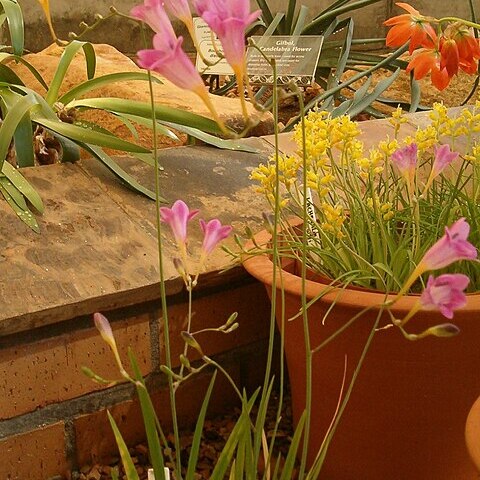Plants (120-)150-400(-600) mm high. Corm conic or globose, 12-30 mm diam., tunics light brown, of medium-textured to coarse fibres, sometimes forming collar. Stem suberect, smooth, usually branched. Leaves 7 to 10, erect, usually ± half as long as stem, narrowly lanceolate, (40-)60-200 x 2-7(-10) mm, acute, rarely oblong-lanceolate and obtuse. Spike horizontal or deflexed, (3-)6-to 10-flowered; bracts oblong to oblanceolate, membranous becoming dry, 4-8 mm long, translucent or flushed pale pinkish, with brown veins and dark brown tips, obtuse or rarely apiculate, inner slightly shorter to slightly longer, with dark brown tips. Flowers 25-35(-40) mm long, usually pale to deep yellow, pale to deep pink, or rarely white, with base of tube, lowermost tepal and inner margins of lower lateral tepals bright yellow to orange, lower tepals with brownish midline running into tube, unscented or weakly scented; perianth tube funnel-shaped, 20-25(-35) mm long with basal tubular portion 5-10(-20) mm long and strongly curved at tip, widening abruptly into flared upper portion; tepals with dorsal largest, suberect, broadly ovate-cordate, 8-12 x 7-10 mm, upper laterals ovate, lower tepals recurved, lower laterals broadly ovate-cordate with margins strongly upcurved, 7-11 x 8-10 mm, lower median ovate, 7-10 x 4-8 mm. Filaments arcuate, 13-15 mm long, included; anthers 5-6 mm long. Style dividing at or slightly beyond anther apices. Capsules subglobose or oblong, 6-8 x 6-8 mm, papillate. Seeds globose with flattened chalaza, slightly wrinkled, glossy reddish brown, 2.0-3.5 mm diam.
More
Perennial herb, geophyte, 0.15-0.30 m high; corm globose-conic; stem erect, smooth, usually several-branched, exceeding leaves, up to 25 mm in diam., tunics light brown. Leaves linear-ensiform, 100-200 mm long, < 1/2 as long as stem. Bracts brown-veined, apex rusty. Inflorescence a 6-10-flowered spike; perianth usually pale yellow or pink with yellow throat; tepals unequal, cordate. Stamens up to 21 mm long; filaments 15 mm long; anthers 4-6 mm long. Ovary with style dividing just beyond anther apex. Flowering time July-Mar. Capsule 6-8 mm long, rugulose, appearing smooth when ripe.
Cormous geophyte, 25-50 cm. Leaves sword-shaped, acute. Flowers yellow, sometimes pink or white, faintly scented.


